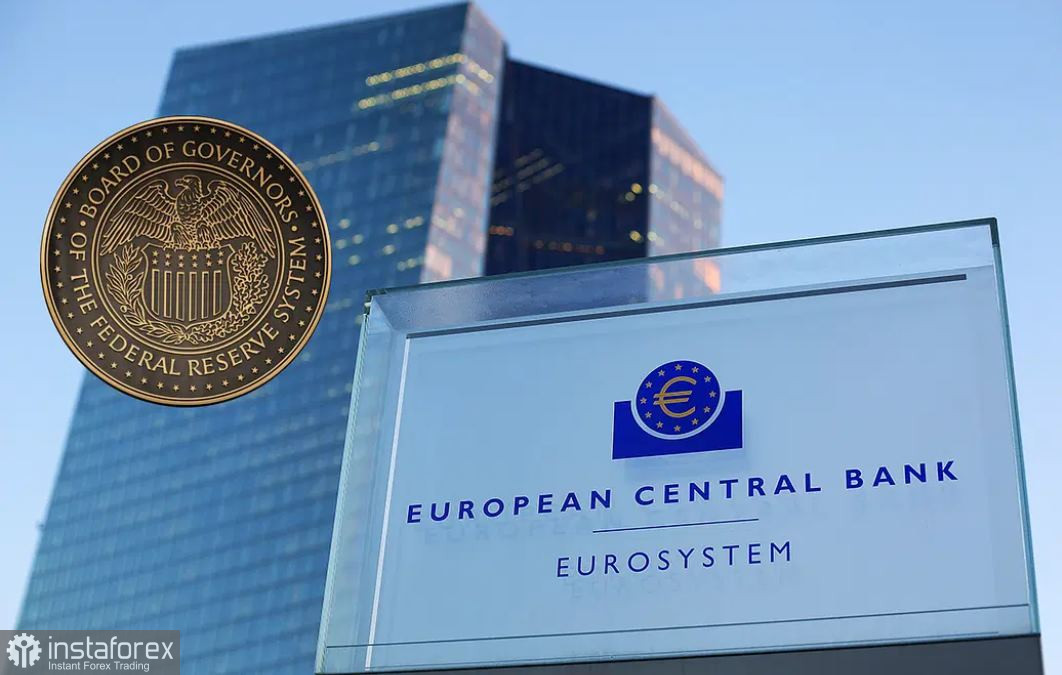For the past two days, buyers of the EUR/USD pair have been hitting the 9th figure's border, but they have been unable to break through the 1.0900 level. As a result, sellers seized the initiative and pulled the price down to the base of the seventh figure. The main cause of such a significant price decline is the strengthening of the US dollar; as a result, the US dollar index somewhat recovered its position, suggesting higher demand for the greenback. The index reached a new 7-week low yesterday, at 101.55, and was already close to a new high today, at 103.00. Conflicting PMI indices that were released throughout Friday's European session added to the pressure on the euro. As a result, the 1.0720 support level was tested by EUR/USD bears (the Tenkan-sen line on the daily chart).
So today, PMI indices were released in several European nations, reflecting a trend that the manufacturing sector is in decline while the service sector is improving. Preliminary data for March have just been released, so some inferences about the behavior of more "complicated" macroeconomic indicators are now possible. For instance, the manufacturing sector's business activity index in France rose somewhat but remained below the critical 50-point limit, coming in at 47.7 points (with growth forecast to 48.5). The situation is much better in the service sector, where the index increased to 55.5 points and appeared to be in the "green zone," marking the fastest rate of development since May last year. German data also revealed a similar pattern. The PMI index decreased, particularly in the manufacturing sector, to 44.4 points. In July 2020, this indicator was at a very low point. In contrast, the index increased to 53.9 points in the service sector (the maximum growth rate since May 2022). The European PMI indices followed the same trend as the aforementioned indicators: in the manufacturing sector, the index fell to 47 points while rising to 55.6 points in the service sector. Since May of last year, this is the best outcome.
The single currency is under a lot of pressure as a result of the released figures.
The EUR/USD bears received new support from American statistics. The overall volume of orders for durable goods declined by 1% in February, according to figures released today, with a growth estimate of 0.4% (in January, the volume decreased by 5%). Without accounting for the transport component, the indicator stayed at zero, contrary to the majority of analysts' predictions of a little but positive gain of 0.2%.
The banking crisis and the echoes of the March meetings
Despite the EUR/USD pair's increased volatility, traders have not been able to pinpoint the direction of price movement: for the bears to resume their southern movement, they must move back into the area of the sixth figure; for the northern trend to resume, they must take hold of the eighth figure. However, neither the buyers nor the sellers of the pair dare to retain sizable "one-sided" positions: as soon as the pair reaches the 1.0720 support level, bears take profits, and bulls do the same when the pair approaches the 8th price level boundaries.

The market is confused. Both sellers and purchasers of EUR/USD are confused by the extensive, yet contradictory information background.
The March ECB and Fed meetings raised more questions than they answered. On the one hand, the central banks raised rates by 25 and 50 points, respectively, following the most fundamental and anticipated scenarios. However, the Central Bank's future judgments are "covered with a fog of uncertainty."
The key point from the March meeting was reiterated by the chairman of the European Central Bank today when addressing the EU summit: the ECB is "determined" to bring inflation back to the target level of two percent, but the decision about future interest rates would be made "based on incoming data." By the way, during the March meeting of the members of the American regulator, Jerome Powell, the head of the Federal Reserve, expressed a similar viewpoint. While saying that this scenario "is not a basic one," he did not expressly rule out a decrease in interest rates this year.
In my perspective, the foreign exchange market has not yet consolidated popular opinion regarding recent events. According to EUR/USD dealers, the Fed is putting pressure on the dollar "at the moment," while the European Central Bank is putting pressure on the euro. But the trend was not started by the central banks. Regulators have not become allies for either EUR/USD buyers or sellers, having connected their future actions to inflation figures.
The ongoing worries about the status of the US financial industry further contribute to the complexity of the fundamental rebus. During the banking crisis, US authorities yesterday announced plans to take action to safeguard the safety of deposits, according to Finance Minister Janet Yellen. Yellen called a private meeting of the Financial Stability Oversight Council, which was made public today. Investors undoubtedly interpret the Ministry of Finance's recent measures as proof that regulators, the Central Bank, and the US government are still concerned about the likelihood of a deepening crisis, despite assurances from US officials to the markets that the banking industry is stable.
Conclusions
Given the high level of uncertainty, the EUR/USD pair is anticipated to vary in a wide price range in the medium term, between the middle and upper lines of the Bollinger Bands indicator on the D1 timeframe, which correspond to the 1.0670 and 1.0850 marks.
Contradictory informational signals and the dangers posed by the potential "spread" of the banking crisis will continue to cause price volatility, increasing and weakening the positions of buyers and sellers of the euro-dollar pair, respectively.





















